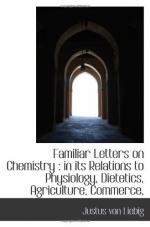What, then, is the use of the butter and the sugar of milk? How does it happen that these substances are indispensable to life?
Butter and sugar of milk contain no fixed bases, no soda nor potash. Sugar of milk has a composition closely allied to that of the other kinds of sugar, of starch, and of gum; all of them contain carbon and the elements of water, the latter precisely in the proportion to form water.
There is added, therefore, by means of these compounds, to the nitrogenised constituents of food, a certain amount of carbon; or, as in the case of butter, of carbon and hydrogen; that is, an excess of elements, which cannot possibly be employed in the production of blood, because the nitrogenised substances contained in the food already contain exactly the amount of carbon which is required for the production of fibrine and albumen.
In an adult carnivorous animal, which neither gains nor loses weight, perceptibly, from day to day, its nourishment, the waste of organised tissue, and its consumption of oxygen, stand to each other in a well-defined and fixed relation.
The carbon of the carbonic acid given off, with that of the urine; the nitrogen of the urine, and the hydrogen given off as ammonia and water; these elements, taken together, must be exactly equal in weight to the carbon, nitrogen, and hydrogen of the metamorphosed tissues, and since these last are exactly replaced by the food, to the carbon, nitrogen, and hydrogen of the food. Were this not the case, the weight of the animal could not possibly remain unchanged.
But, in the young of the carnivora, the weight does not remain unchanged; on the contrary, it increases from day to day by an appreciable quantity.
This fact presupposes, that the assimilative process in the young animal is more energetic, more intense, than the process of transformation in the existing tissues. If both processes were equally active, the weight of the body could not increase; and were the waste by transformation greater, the weight of the body would decrease.
Now, the circulation in the young animal is not weaker, but, on the contrary, more rapid; the respirations are more frequent; and, for equal bulks, the consumption of oxygen must be greater rather than smaller in the young than in the adult animal. But, since the metamorphosis of organised parts goes on more slowly, there would ensue a deficiency of those substances, the carbon and hydrogen of which are adapted for combination with oxygen; because, in the carnivora, nature has destined the new compounds, produced by the metamorphosis of organised parts, to furnish the necessary resistance to the action of the oxygen, and to produce animal heat. What is wanting for these purposes an Infinite Wisdom has supplied to the young in its natural food.
The carbon and hydrogen of butter, and the carbon of the sugar of milk, no part of either of which can yield blood, fibrine, or albumen, are destined for the support of the respiratory process, at an age when a greater resistance is opposed to the metamorphosis of existing organisms; or, in other words, to the production of compounds, which, in the adult state, are produced in quantity amply sufficient for the purpose of respiration.




